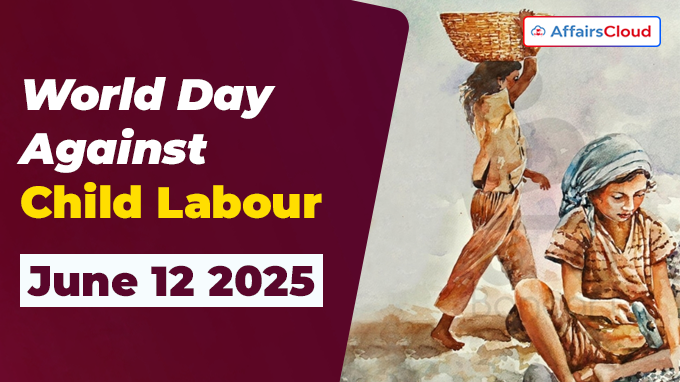 The United Nations (UN’s) World Day Against Child Labour (WDACL) is observed annually across the globe on June 12 to raise awareness about child labour and mobilize efforts for its elimination.
The United Nations (UN’s) World Day Against Child Labour (WDACL) is observed annually across the globe on June 12 to raise awareness about child labour and mobilize efforts for its elimination.
- In 2025, this day marks the 26th anniversary of the adoption of the International Labour Organization (ILO) Convention No. 182 on the Worst Forms of Child Labour (1999).
2025 Theme:
The theme for WDACL 2025, “Progress is clear, but there’s more to do: let’s speed up efforts!”, highlights achievements while urging intensified action to meet the Sustainable Development Goal (SDG) Target 8.7, which aims to end child labour in all forms by 2025.
Background:
i.WDACL was established in 2002 by the ILO, the only tripartite agency of the UN dedicated to promoting social justice and internationally recognised labour and human rights.
ii.The first WDACL was observed on June 12, 2002.
What is Child Labour?
i.Child labour is defined as work that is mentally, physically, socially, or morally harmful to children and interferes with their schooling.
ii.It includes the unconditional worst forms of child labour such as slavery, forced labour, prostitution, trafficking, and involvement in illegal activities, as well as work performed by children below the minimum legal age, as defined by national laws and international standards.
Call to Action for 2025:
The ILO and the United Nations Children’s Fund (UNICEF) have called upon all stakeholders to:
i.Ensure universal ratification and effective implementation of ILO Conventions No. 138 (Minimum Age) and No. 182 (Worst Forms of Child Labour).
ii.Promote integrated national policies that connect social protection, education, and decent work for adults.
iii.Enhance cross-border cooperation to protect vulnerable groups like migrant children, including ongoing efforts like the Cambodia–Thailand child protection initiatives.
Note: Durban Call to Action was adopted in May 2022, during the 5th Global Conference on the Elimination of Child Labour held in Durban, South Africa, it reinforced the global commitment through the principles of prevention, protection, and partnership.
Global Report – Child Labour: Global Estimates 2024
On June 11, 2025, the ILO and UNICEF jointly released a report titled “Child Labour: Global Estimates 2024, Trends and the Road Forward” , during a high level event at the 113th International Labour Conference (ILC) held in Geneva, Switzerland.
Key findings:
- Nearly 138 million children(aged 5–17) were engaged in child labour in 2024, down by 22 million since 2020.
- Of the total, 54 million children (39%) were involved in hazardous work posing risks to their health, safety, or development.
- Agriculture remains the dominant sector (61%), followed by services (27%) and industry (13%)
Region-Wise Distribution:
i.The Africa region records the highest incidence of child labour, with 20% of children affected, amounting to 72 million.
ii.This is followed by the Asia and the Pacific region, with 62 million children (representing 7%), the Americas with 11 million (5%), Europe and Central Asia with 6 million (4%), and the Arab States with 1 million children, accounting for 3%.
Income-Level Analysis:
Middle-income countries account for 84 million (56%) of child labourers.
- Lower-middle-income: 9% of all children
- Upper-middle-income: 7% of all children.
Note: As per the Census 2011 data, India recorded approximately 1.01 crore (10.1 million) children aged between 5 and 14 years engaged in child labour.
India’s Measures Against Child Labour:
1. Child Labour (Prohibition & Regulation) Act, 1986
- Prohibits employment of children below 14 years in 18 occupations and 65 processes deemed hazardous.
2. National Policy on Child Labour, 1987
- Focuses on rehabilitation through special schools.
- Offers income support to families of rescued children.
3. National Child Labour Project (NCLP Scheme), 1988
- Provides bridge education for children aged 9–12 years.
- Offers health check-ups, midday meals, and a ₹400 monthly stipend per child.
4. PENCIL (Platform for Effective Enforcement for No Child Labour) Portal (2017)
- An online platform for reporting child labour violations.
- Tracks rescue operations, education progress, and rehabilitation status.




